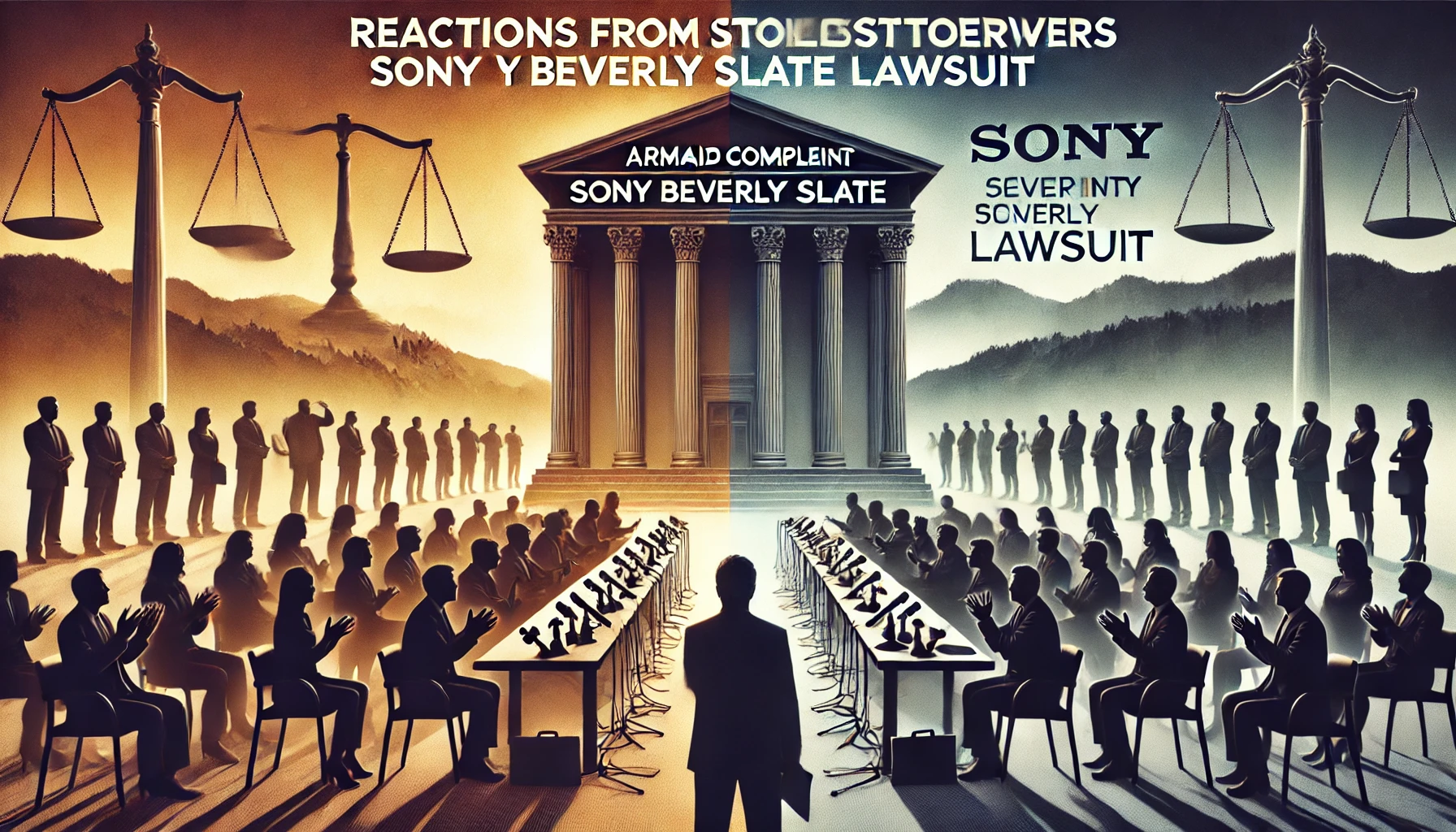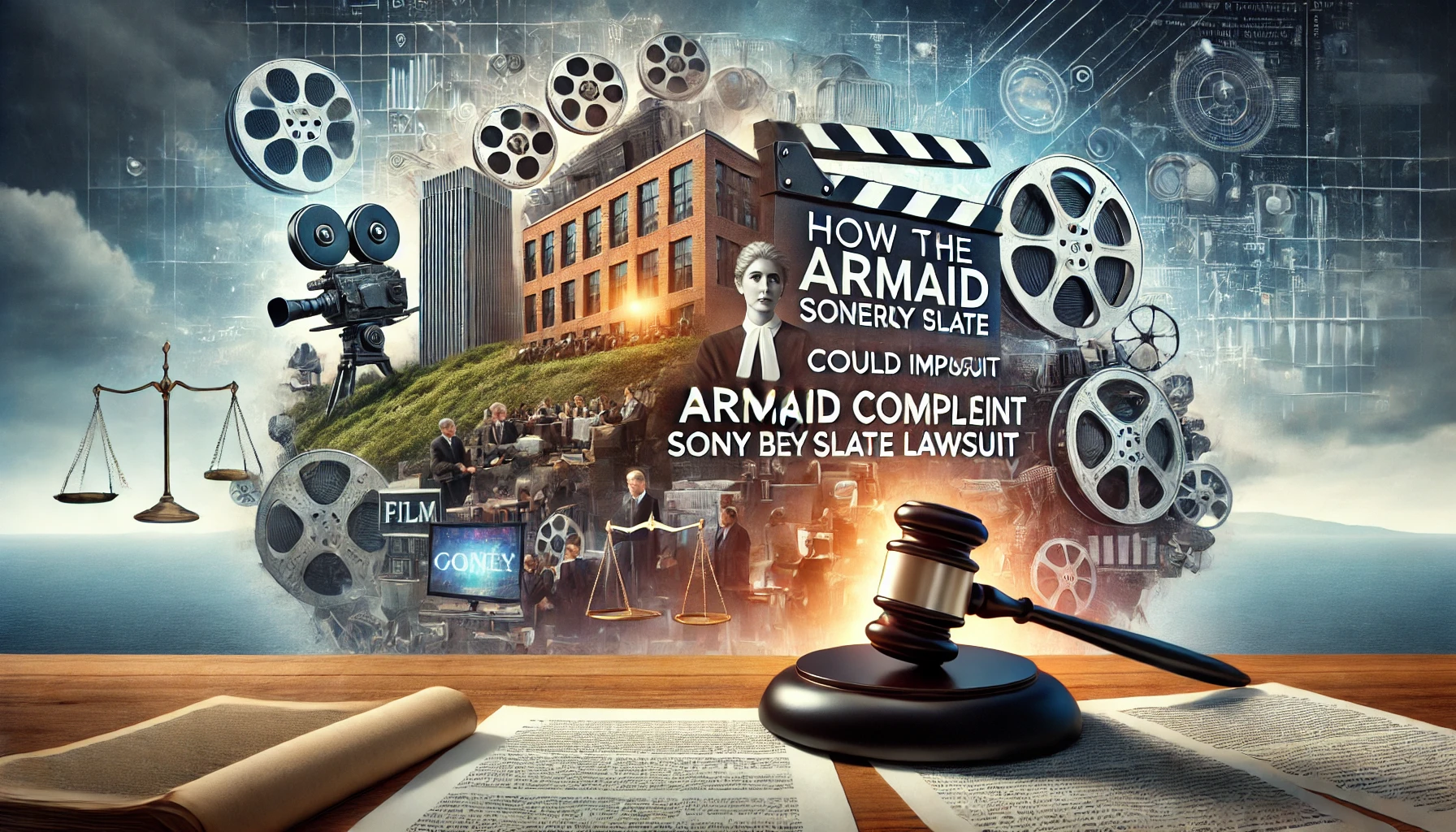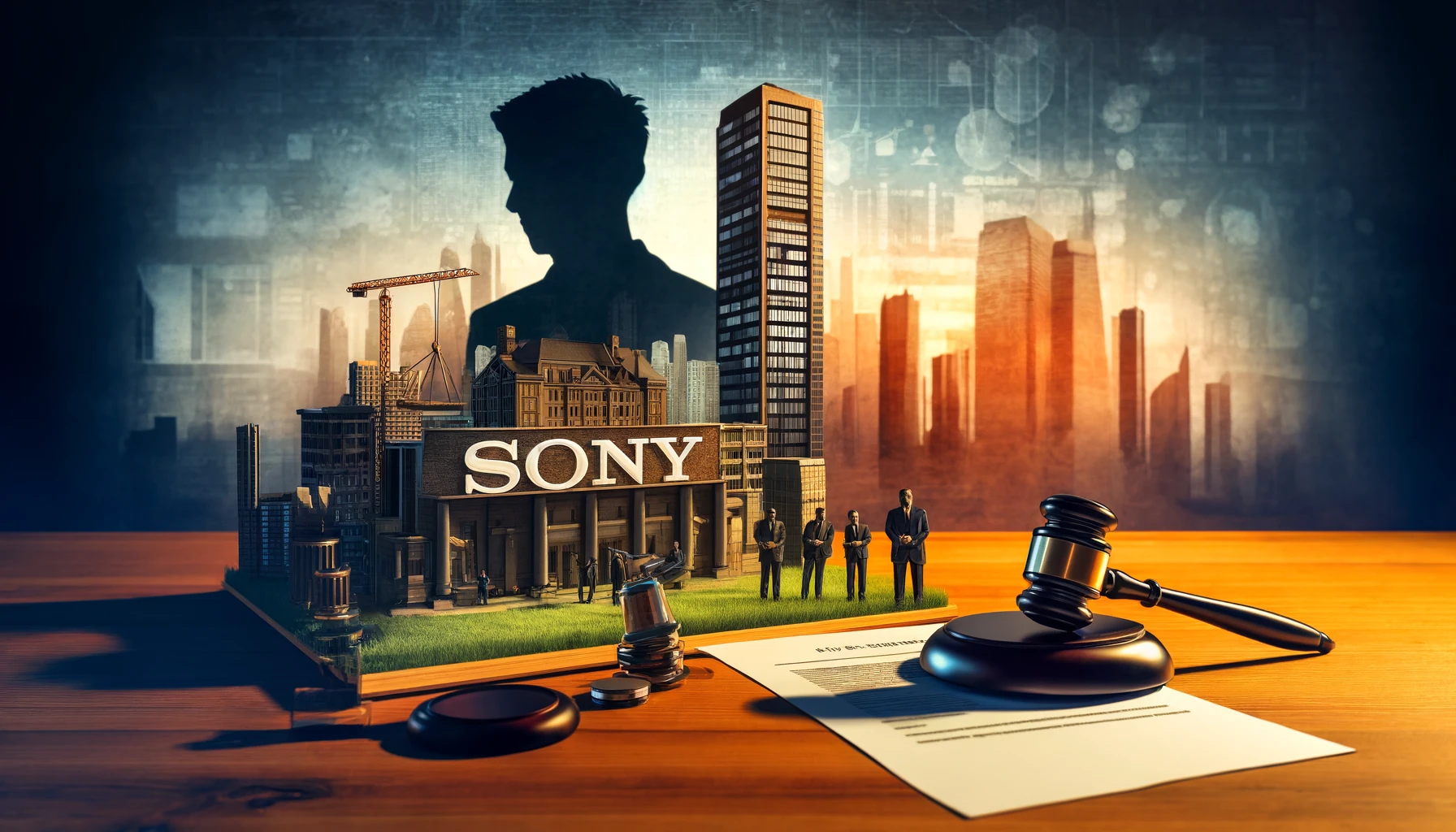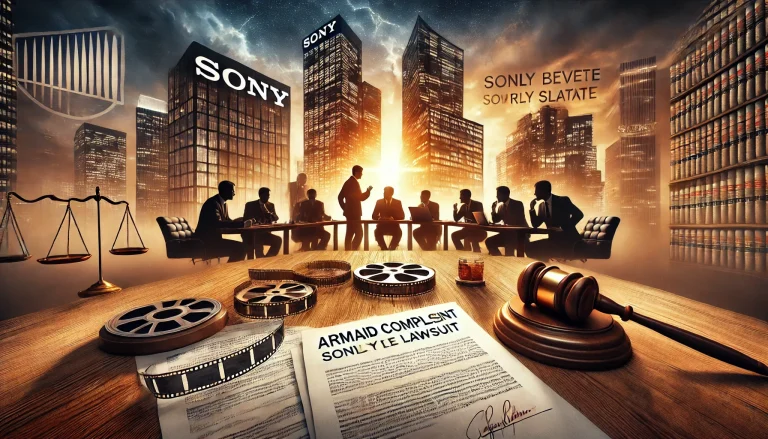The Armaid Complaint Sony Berverly Slate Lawsuit has garnered significant attention in recent weeks, raising questions about legal obligations and industry practices. This legal dispute highlights the complex relationship between corporations and the individuals or entities they engage with, drawing scrutiny from stakeholders across the industry.
At the heart of the Armaid Complaint Sony Berverly Slate Lawsuit are allegations that could potentially reshape how similar agreements are structured in the future. The details of the case reveal a multifaceted conflict involving creative control, financial stakes, and contractual compliance.
As the Armaid Complaint Sony Berverly Slate Lawsuit unfolds, it has sparked widespread discussions about accountability and fairness. Observers are keenly following the developments, understanding that the outcome may have far-reaching implications.
The Origins of the Armaid Complaint Sony Berverly Slate Lawsuit
The Armaid Complaint Sony Berverly Slate Lawsuit stems from a series of disputes between the involved parties over contract terms and deliverables. The case reportedly began when Armaid, a party associated with creative or production roles, raised concerns about how their agreements were handled by Sony.
The origin of the lawsuit can be traced to the Beverly Slate Project, which was a collaborative venture involving multiple stakeholders. Armaid alleges that Sony failed to adhere to key terms in their contract, leading to financial and reputational damages. This has set the stage for a high-profile legal battle.
The lawsuit also touches on a history of communication issues between the parties. Claims indicate that misunderstandings and delays in resolving disputes exacerbated the situation, prompting Armaid to file a formal complaint.
A critical aspect of the origins lies in the potential mismanagement of intellectual property rights. Armaid has accused Sony of leveraging creative assets in ways that breach their agreement, further escalating tensions.
A timeline of events in the case highlights key moments:
| Event | Date | Significance |
| Initial Agreement Signed | January 2021 | Marked the start of the collaboration |
| Disputes Arise | September 2022 | Armaid raises concerns with Sony |
| Lawsuit Filed | November 2023 | Formal legal action initiated |
Key Allegations Driving the Legal Conflict
The armaid complaint sony beverly slate lawsuit is primarily driven by allegations of contract violations. Armaid asserts that Sony failed to honor the financial commitments outlined in their agreement, resulting in substantial losses.
Another major allegation concerns creative control. Armaid claims that Sony made unilateral decisions regarding the Beverly Slate Project, sidelining other contributors and ignoring prior agreements.
Accusations of intellectual property misuse have also been central to the case. Armaid alleges that Sony exploited copyrighted materials without proper licensing or credit.
Some of the allegations also revolve around delayed payments and non-disclosure of critical project details. This has been framed as a breach of trust by Armaid.
The lawsuit also points to potential conflicts of interest within Sony’s handling of the project, raising questions about transparency and accountability in corporate practices.
Understanding the Role of Sony in the Legal Dispute
Sony, as a major player in the entertainment industry, has been accused of leveraging its dominant position in the Armaid Complaint Sony Berverly Slate Lawsuit. The company is alleged to have used its influence to override contractual agreements.
Sony’s role in the dispute involves decisions related to project timelines, budget allocations, and intellectual property management. Armaid has argued that these actions breached the terms of their collaboration.
From Sony’s perspective, they have denied most allegations, asserting that they acted within the bounds of their contractual rights. Legal filings indicate that Sony plans to defend its actions on the grounds of contractual ambiguity and business necessity.
The company’s reputation is also at stake. Given its high profile, Sony faces scrutiny over how it manages partnerships and resolves disputes with collaborators.
This lawsuit could potentially serve as a case study for other corporations on navigating legal conflicts with creative professionals and smaller entities.
How the Armaid Complaint Sony Beverly Slate Lawsuit Could Impact the Industry
The Armaid Complaint Sony Berverly Slate Lawsuit has the potential to set new legal precedents in the entertainment and creative industries. The case could redefine how contracts are negotiated, particularly in terms of intellectual property and creative control.
One significant impact could be on industry policies. If Armaid prevails, companies like Sony may need to adopt stricter compliance measures to avoid similar disputes.
For independent creators and smaller entities, the lawsuit highlights the importance of clear, enforceable contracts. It serves as a reminder that legal protections must be in place when working with large corporations.
A potential outcome could involve changes in how creative credits are attributed. The industry may see a shift toward more equitable recognition of contributions in collaborative projects.
Key Impacts of the Lawsuit:
- Policy Changes: Enhanced contract regulations across the industry.
- Power Dynamics: Greater balance between corporations and creatives.
- Legal Precedents: New standards for handling disputes and intellectual property.
This lawsuit underscores the need for accountability and fair practices, signaling a possible turning point for the entertainment sector.
Legal Strategies and Counterarguments Presented by the Parties
Sony’s legal strategy in the Armaid Complaint Sony Berverly Slate Lawsuit revolves around challenging the validity of Armaid’s claims. They argue that the contract terms were either fulfilled or that any ambiguities in the agreement left room for interpretation, thereby justifying their actions.
Armaid’s legal team is focusing on presenting evidence of specific breaches, including delayed payments, intellectual property misuse, and unauthorized decision-making. Their arguments emphasize how these breaches caused significant financial and reputational damage.
A key counterargument from Sony is that some of Armaid’s allegations fall outside the agreed contractual terms, framing them as exaggerations or misrepresentations of facts. Sony also points to industry norms, suggesting that their actions align with standard practices.
Armaid counters this by highlighting communications and agreements that indicate mutual understanding of the disputed terms. They argue that Sony’s actions represent a breach of trust and fair dealing.
The court will also consider expert testimony on both sides. Sony is expected to bring in legal and industry professionals to justify their operational decisions, while Armaid may rely on testimony from collaborators and analysts to bolster their claims.
The Broader Significance of the Dispute in Entertainment Law
The Armaid Complaint Sony Berverly Slate Lawsuit is significant because it touches on key legal issues in the entertainment industry, such as intellectual property rights, creative control, and contractual transparency. This case could establish important precedents for how disputes between creators and corporations are handled.
One of the broader implications is the potential shift in power dynamics. If Armaid succeeds, it may encourage smaller players to challenge corporate practices that they perceive as unfair, fostering greater accountability.
Another area of significance lies in how this case could influence the drafting and enforcement of contracts. The industry might see an increased emphasis on precise language and comprehensive clauses to avoid similar disputes in the future.
A particularly interesting aspect of this case is its potential to reshape the role of intellectual property in collaborative projects. The lawsuit questions how ownership and control of creative content should be distributed among contributors.
Legal scholars and practitioners are closely monitoring this case, as its outcome could lead to more robust protections for creative professionals while also imposing stricter compliance obligations on corporations.
A Timeline of Events in the Sony Beverly Slate Case
The timeline of the Armaid Complaint Sony Berverly Slate Lawsuit offers valuable insights into how the dispute escalated over time. Each key event marks a significant turn in the case.
| Event | Date | Significance |
| Initial Contract Signed | January 2021 | Marked the beginning of collaboration |
| Project Launch | June 2021 | Production under Sony’s oversight |
| First Dispute Raised | September 2022 | Armaid flagged potential violations |
| Mediation Attempted | February 2023 | Failed to resolve disagreements |
| Lawsuit Filed | November 2023 | Formal legal action was initiated |
This timeline illustrates the progression of events and highlights critical moments that defined the trajectory of the lawsuit.
Reactions from Stakeholders and Observers
The Armaid Complaint Sony Berverly Slate Lawsuit has elicited varied reactions from stakeholders and industry observers. Many creative professionals have expressed support for Armaid, viewing the lawsuit as a stand against corporate overreach.
On the corporate side, some stakeholders argue that disputes like these are common in the entertainment industry and reflect the complexities of managing large-scale projects. They see Sony’s defense as a necessary effort to protect its business practices.
Legal experts have highlighted the case as a potential landmark, with some emphasizing the need for greater transparency and fairness in contractual agreements. They believe the outcome could serve as a cautionary tale for both corporations and creatives.
Media coverage of the case has been extensive, with headlines often framing it as a David-versus-Goliath battle. Public opinion appears divided, with some sympathizing with Armaid’s plight and others questioning the validity of their claims.
The broader entertainment community is closely watching the case, as its resolution could set new standards for how disputes are addressed, ultimately shaping the future of industry practices.
Examining Precedents Cited in the Armaid Complaint
The Armaid Complaint Sony Berverly Slate Lawsuit draws heavily on legal precedents that underline issues of contract enforcement and intellectual property rights. These cases serve as a foundation for Armaid’s arguments against Sony.
One of the key precedents cited involves disputes over intellectual property in collaborative projects. In similar past cases, courts have ruled in favor of creators when contracts lacked clear provisions for ownership and usage rights.
Another cited precedent relates to breaches of fiduciary duty. Armaid’s legal team argues that Sony’s actions demonstrate a disregard for the trust inherent in their partnership, a claim often upheld in cases involving delayed payments or unauthorized decisions.
The lawsuit also references cases where corporations were held accountable for unequal power dynamics, emphasizing the importance of fair dealing in contractual relationships.
Armaid’s reliance on these precedents strengthens its position by showing that courts have historically taken a strict stance against actions that undermine transparency, fairness, and trust in business agreements.
Financial and Reputational Risks Involved for Sony
The Armaid Complaint Sony Berverly Slate Lawsuit poses significant financial risks for Sony. If the court rules in favor of Armaid, Sony may face hefty penalties, including compensation for damages, legal fees, and potential punitive charges.
Reputational damage is another critical concern. As one of the most prominent names in the entertainment industry, Sony’s image could be tarnished by allegations of unfair practices, potentially impacting relationships with future collaborators.
A breakdown of potential financial risks includes:
| Risk Type | Potential Impact |
| Legal Penalties | Multi-million-dollar fines |
| Project Delays | Loss of future revenues |
| Stakeholder Dissatisfaction | Weakened investor confidence |
Beyond finances, the case could affect Sony’s ability to attract top creative talent. Allegations of mishandling partnerships may make creators wary of entering agreements with the company.
To mitigate these risks, Sony will need to demonstrate its commitment to fair practices, whether through a strong legal defense or by settling the case amicably.
Potential Outcomes of the Armaid Complaint Sony Berverly Slate Lawsuit
The Armaid Complaint Sony Berverly Slate Lawsuit could result in a variety of outcomes, each with unique implications for the parties involved. A favorable ruling for Armaid would likely include financial compensation and potentially public acknowledgment of Sony’s alleged breaches.
If Sony prevails, the case may underscore the importance of contractual clarity, signaling the need for detailed agreements that leave little room for interpretation.
Another potential outcome is an out-of-court settlement. This would allow both parties to avoid prolonged litigation and protect their reputations while resolving the dispute privately.
Regardless of the ruling, the lawsuit is expected to influence how contracts are negotiated and enforced in the future. Industry players may adopt stricter compliance measures and clearer terms to avoid similar disputes.
In addition to legal outcomes, the case could lead to policy reforms within companies, emphasizing fairness and transparency in collaborations.
What This Legal Battle Means for Industry Policies
The Armaid Complaint Sony Berverly Slate Lawsuit highlights gaps in current industry policies regarding contractual agreements and intellectual property management. The case raises questions about whether existing frameworks sufficiently protect the rights of creators and collaborators.
One likely outcome is a push for standardized contract terms in entertainment agreements, ensuring that obligations and rights are clearly defined and enforceable. This could particularly benefit smaller players who may lack legal expertise.
Companies like Sony may also be compelled to adopt more transparent practices, such as better communication and fairer distribution of creative control. Industry bodies might develop guidelines to address these issues.
Policy reforms could extend to dispute resolution as well. Mediation and arbitration may become more common as alternatives to lengthy court battles, providing quicker and less costly solutions.
If the lawsuit sets new legal precedents, it could reshape how intellectual property is assigned and managed, leading to a fairer balance of power between corporations and creators.
Monitoring the Progress of the Case: What’s Next?
As the Armaid Complaint Sony Berverly Slate Lawsuit moves forward, several critical developments are expected. The court will likely review key evidence, including contract documents, correspondence, and expert testimonies.
Observers are anticipating preliminary rulings that could shape the direction of the case. Early motions and court decisions may offer insights into how the legal arguments are being received.
Public interest in the case remains high, with updates expected to come through court filings, media coverage, and official statements from the parties involved.
Key milestones to watch include settlement negotiations, expert testimonies, and the final judgment. Each of these steps will provide clarity on the potential resolution of the lawsuit.
The outcome of the case could have long-term implications, making it essential for stakeholders to stay informed about its progress. Whether through legal channels or public discourse, the Armaid Complaint Sony Berverly Slate Lawsuit is poised to influence the entertainment industry significantly.
Conclusion
The Armaid Complaint Sony Berverly Slate Lawsuit is more than just a legal dispute; it is a case that underscores the complexities of creative collaborations in the entertainment industry. At its core, the lawsuit highlights the importance of clear contractual agreements, transparency, and fair dealings between corporations and collaborators.
This case has brought attention to critical issues such as intellectual property rights, financial accountability, and power dynamics in business relationships. Its resolution could have far-reaching implications, not only for Sony and Armaid but for industry practices as a whole.
As the case progresses, it serves as a reminder to industry players of the need to address potential conflicts proactively. Regardless of the outcome, this lawsuit has already begun shaping conversations around ethical practices, legal frameworks, and equitable treatment within the entertainment sector.
Recommended Articles:
Matthew Eisert Physician Assistant: Leveraging Teamwork to Drive Excellence in Healthcare Delivery
Fort Worth Mesothelioma Lawyer Vimeo: A Trusted Platform for Legal Awareness
Candice Emiko Norris Virginia: Bridging Gaps and Building Opportunities for Generations




